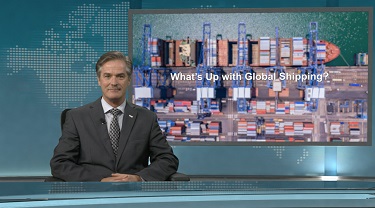Mixed signals are muddying an already-murky outlook. Trusted leading indicators are all over the map. Copper prices tanked in 2015 with no corresponding drop in GDP. Stock markets are indicating weakness, but the signal there is mixed. PMIs are softening, but policy turmoil is the probable cause. Extraordinary monetary measures have likely compromised the yield curve’s prognosticating powers. At the same time, and in direct contrast, housing markets in the U.S. and EU suggest there’s still upward potential in the world’s engine economies. And then there’s global shipping—it often telegraphs near-term direction. In all the confusion, is it helping us out?
Contrary to many of today’s high-frequency indicators, this one is rising. Shipping of dry bulk goods is a very upstream indication of the global economy, as it involves inputs to many different industrial production processes. The price of this shipping is captured by the Baltic Exchange Dry Index, which ended last year on a jumpy but decidedly down trend. It bottomed out in mid-February—but since then, the index has shown a solid rebound, more than doubling through late June.
Even better, each of the sub-indexes for different size-classes of shipping is up from the mid-February trough. Not all of them are increasing as steadily as the main index, but it is very reassuring to see that the largest class of vessel, known as Capesize, has recovered dramatically from its lowest level in the post-recession period to one that is consistent with respectable global growth. Overall, the Baltic index is not saying that the world economy is taking off, but rather that the worst of the current slowdown may now be behind us.
Container shipping covers a different part of the market. Sure, there are more bulk goods that are now going by container, but much of what makes it into those steel boxes is final goods destined for sale by a wholesaler or retailer. The Harpex Index covers this world, and like the Baltic, is coming off a worrisome low. Things were looking very strong for container shipments in early 2018, when the Harpex zoomed up quickly to its highest level in the post-stimulus period, flying in the face of anti-trade threats and actual policy actions. Well, through the rest of the year, every inch of that ground was lost, with this index also bottoming out in early 2019. Since then, it has chalked up a hasty, although partial, recovery, and currently sits comfortably above its five-year average.
Again, it is the larger vessels that are driving the increase. All classes are either holding their own or growing this year, but the 8,500 twenty-foot-equivalent-unit (TEU) vessels are the ones that have shown the most dramatic and consistent increases in lease rates, followed closely by the 6,500 TEU units. Demand for these large vessels has been in the doldrums since early 2015, so this recent move is their second attempt at breaking out of the multi-year funk.
Will the up-trend continue? It’s hard to say—global trade is still beset by seemingly arbitrary protectionist and nationalist policy moves, with most unable to see near-term resolution. As such, potential investment is being parked on the sidelines, waiting out the mayhem. Then why the current run-up? Well, preparation is now underway for the critical and very lucrative fall selling season, and in an environment where there is plenty of demand. Consider the U.S., with its relentless employment increases and sharply increased labour force engagement—there’s a lot more money in the economy than there was at this time last year. And the EU, with its current troubles, is still sporting a very low unemployment rate by historical standards. It could well be that pent-up spending pressure is finally pushing activity upward in spite of the concerns about where trade policy is going to land.
The bottom line?
Confusion on the global trade front is spilling over into economic indicators, and compromising their reliability. Among the few that are actually heading north, world shipping activity is one that’s a tangible representation of actual activity—activity that’s more upstream, and a potential indicator of growth to come. While not enough to hang an entire forecast on, shipping indicators bear watching over the coming weeks and months for signs that the economy is sailing on in spite of contrary winds.
This commentary is presented for informational purposes only. It’s not intended to be a comprehensive or detailed statement on any subject and no representations or warranties, express or implied, are made as to its accuracy, timeliness or completeness. Nothing in this commentary is intended to provide financial, legal, accounting or tax advice nor should it be relied upon. EDC nor the author is liable whatsoever for any loss or damage caused by, or resulting from, any use of or any inaccuracies, errors or omissions in the information provided.





